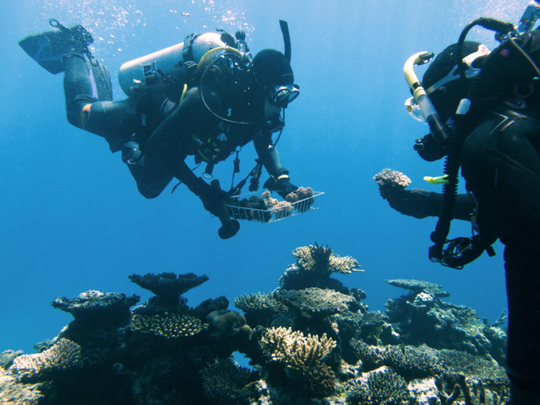
THE GREAT BARRIER REEF
After a plunge beneath the crystal-clear water to inspect a coral reef, Neal Cantin pulled off his mask and shook his head.
“All dead,” he said.
Yet even as he and his dive team of international scientists lamented the devastation that human recklessness has inflicted on the world’s greatest system of reefs, they also found cause for hope.
As they spent days working through a stretch of ocean off the Australian state of Queensland, Cantin and his colleagues surfaced with sample after sample of living coral that had somehow dodged a recent die-off: hardy survivors, clinging to life in a graveyard.
“We’re trying to find the super corals, the ones that survived the worst heat stress of their lives,” said Cantin, a researcher with the Australian Institute of Marine Science in Townsville.
The goal is not just to study them, but to find the ones with the best genes, multiply them in tanks on land and ultimately return them to the ocean where they can continue to breed. The hope is to create tougher reefs — to accelerate evolution, essentially — and slowly build an ecosystem capable of surviving global warming and other human-caused environmental assaults.
The research here is part of a worldwide push that is growing increasingly urgent. After decades of accumulating damage, followed by a huge die-off in 2015 and 2016, some scientists say they believe half the coral reefs that existed in the early 20th century are gone.
Instead of standing around watching the rest of them die, a vanguard of reef experts is determined to act.
In Florida, they are pioneering techniques that may allow the rapid re-establishment of reefs killed by heat stress. In Hawaii, they are studying the biology of corals that somehow managed to cling to life as an earlier generation of people dumped raw sewage into a magnificent bay. In the Caribbean, countries are banding together to create a genetic storage bank for corals, a backup plan if today’s reefs all die. “We created these problems,” said Michael P. Crosby, president of the Mote Marine Laboratory & Aquarium in Sarasota, Florida, one of the institutions leading this work. “We have to get actively involved in helping the corals come back.”
Risks and questions
Yet this new push to aid the world’s reefs comes with its own risks, and with many questions.
A large-scale restoration effort could be expensive, and so far, governments have put up only modest sums, despite the hit that their multibillion-dollar tourism industries could take from continued deterioration of the reefs. Private philanthropists — including Paul G. Allen, the co-founder of Microsoft — are paying for much of the early work, spending millions. But will they ultimately commit billions?
And while scientists are trying modest approaches first, the most effective strategy for saving reefs in the long run might be through genetic methods, including selective breeding or transferring heat-resistance genes into corals. That type of thing has been done for crops, but would it be ethical to do it in the wild?
“How do you decide what interventions are right and when to intervene?” said Madeleine van Oppen, a professor of marine biology at the University of Melbourne who is leading the experiments in Australia, aiming at what she calls the “assisted evolution” of coral reefs. “There’s a long road ahead; that’s why we’re starting now.”
Even the scientists who have plunged into this kind of work are asking themselves if it is the right thing and if it would ever be enough given the scale of climate change’s predicted impact. “To think we’ve had to turn our science this way is kind of terrifying, but that is what we’ve had to do,” said Ruth Gates, a coral researcher who is heading up the work in Hawaii.
Scientists first warned decades ago that coral reefs were particularly sensitive to heat stress and would be among the earliest victims of global warming if emissions were not brought under control.
They were ignored, and humanity continued burning fossil fuels with abandon — setting up an early test of whether the scientific predictions about global warming could be believed.
Most of the heat trapped by those emissions has gone into the oceans, which have now warmed enough that just a bit of additional heat can cause massive coral die-offs. The extra jolt arrives during El Nino weather patterns that warm large parts of the tropics.
The first global coral die-off began in 1982, and now they seem to be happening every few years. Along the Great Barrier Reef, the El Nino-related heatwave of 2015-16 left 35 to 50 per cent of the corals dead along a 650-mile stretch of the Queensland coastline, a profound blow to what was the single most impressive reef on Earth.
“It’s not too late to be aggressive and make changes to preserve the reef of the future,” Cantin said. But, he added, without a broad effort that includes tackling the emissions causing climate change, reefs could largely die within this century.
The loss of coral reefs is not just an aesthetic disaster. A half-billion people depend on reef fish for food, and in some island nations, they are essentially the only source of protein.
— New York Times News Service












